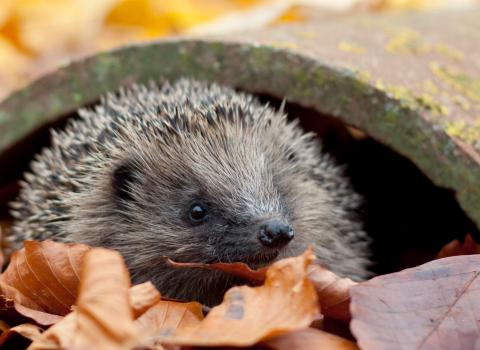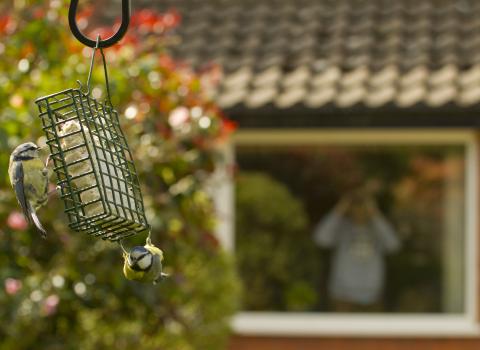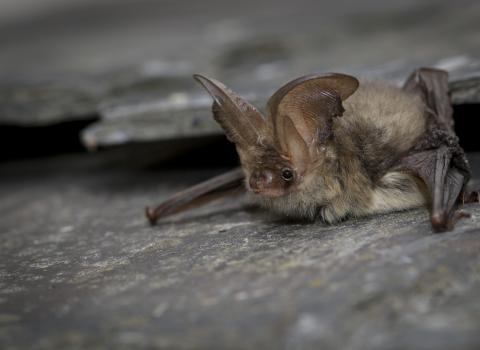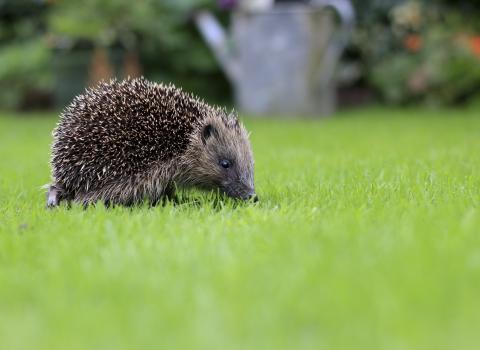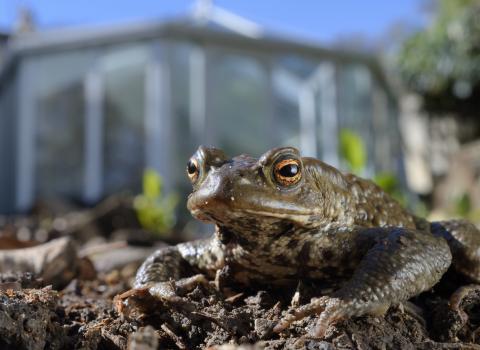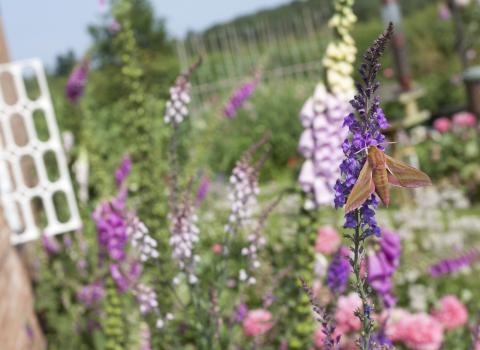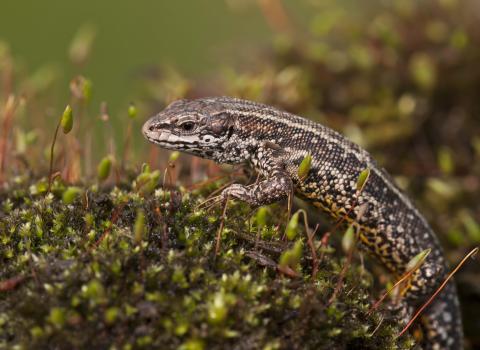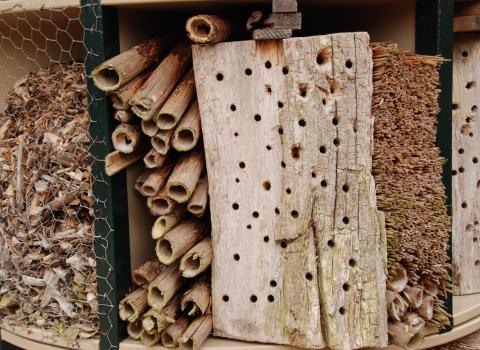Go wild in your garden!
Large or small, your garden can be a mosaic in a wider network of natural havens, linking urban green spaces with nature reserves and the countryside. Creating habitats in your garden is simple and easy to do, and can benefit a whole host of garden visitors.
Take a look our wild ideas and features below to get you started. Then sit back, enjoy the view and see who visits!
Create a habitat for birds
Over the past 50 years, many ’common’ birds have dramatically declined. No-one knows for sure the reasons for this, but changing agricultural practices and a lack of food in the summer and winter have taken their toll.
You can help attract birds to your garden by leaving out feeders in summer and winter, providing water or by putting out a nest box.
Different species of bird prefer different food types, and by providing a range of food you could attract up to 50 different species to your garden! Take a look at our quick guide below to food types and the birds that will enjoy them, or download the PDF for more details.
Bird food
Who eats what?
| Mixed seeds | Blackbird, blue tit, chaffinch, collared dove, dunnock, greenfinch, house sparrow, robin, song thrush |
| Niger seeds | Goldfinch, siskin |
| Black sunflower seeds | Blue tit, chaffinch, collared dove, goldfinch, great tit, greenfinch, house sparrow, siskin |
| Sunflower hearts | Blackbird, blue tit, chaffinch, goldfinch, great spotted woodpecker, great tit, greenfinch, house sparrow, long-tailed tit, robin, siskin, song thrush |
| Suet or fat balls | Blackbird, blue tit, coal tit, dunnock, great tit, long-tailed tit, robin, starling, wren |
| Peanuts | Blue tit, chaffinch, collared dove, dunnock, great spotted woodpecker, great tit, greenfinch, long-tailed tit, siskin |
| Mealworms | Blackbird, blue tit, great tit, house sparrow, long-tailed tit, robins, song thrush, starling, wren |
| Fruit | Blackbirds, fieldfare, redwing, robins, waxwings |
Natural nest sites
A dense shrubbery will provide nest sites for species such as blackbirds which will not use nest boxes. If you are planning to plant some shrubs, choose hawthorn, firethorn (Pyracantha), Berberis, California lilac (Ceanothus), or Cotoneaster. Their thorny branches make good nesting cover, and they also produce berries, a natural bird food, as well as nectar for butterflies and bees.
Any regularly clipped hedge becomes very dense and so can be ideal nesting cover. Even species such as Leylandii, which has little other wildlife value, will be used by birds for nesting and roosting. Climbers such as ivy, clematis and honeysuckle make ideal nest sites if allowed to form dense tangles against a trellis or wall.
Bird boxes
As natural nesting sites are in decline, many different birds such as blue tits, great tits, house sparrows, starlings, swifts, swallows and even owls will use a nest box if it is provided for them. Different species require different box designs.
Download our PDF guide below or find more information here.
Creating a habitat for bats
Bats are fascinating animals that have historically undergone serious decline in Britain. There are 18 species of bat in the UK with 11 of these recorded in Lincolnshire. They are all protected by both UK (Wildlife & Countryside Act 1981, as amended) and European law (Conservation (Natural Habitats &c.) Regulations 1994). Different species have different roosting preferences, e.g. buildings or trees, and may use different sites throughout the year e.g. maternity sites or hibernation sites.
Buildings and trees
Bats often roost in buildings and rarely cause problems for householders. Both old and new buildings may support bats as they will use warm cavities and roof spaces for breeding and/or roosting in summer. Bats will also use buildings for hibernation where conditions are cool and moist (e.g. cellars).
Some species prefer to roost in trees, using features such as holes, cracks, loose bark or dense ivy growth.
If in doubt check with the Lincolnshire Bat Group before carrying out any work on large trees or buildings.
Bat boxes
Wooden bat boxes can be put up on buildings or large trees to replicate the cavities bats use to roost in. Specially designed ‘bat bricks’ can also be incorporated into new buildings to provide a permanent self-contained roost space within the walls, or access tiles can be fitted to roofs to allow bats to use loft spaces.
We recommend using the Kent-style Bat Box as it is effectively self-cleaning and it's easy to check if bats are using them without the need to disturb them. It also prevents birds trying to nest in them as chicks can become stuck in the box-shaped designs.
Download our PDF below and find out how you can make your own bat box!
Make a home for hedgehogs
All a hedgehog needs for the winter is an undisturbed area away from the winter elements. Even a pile of leaves and twigs in the corner of the garden would be tempting to a homeless hedgehog.
Hedgehog boxes
You can make a custom made home by building a hedgehog box or using an old upturned crate covered in soil or wood; alternatively simply allow room under your garden shed or create a large log pile.
Bonfires
Hedgehogs may crawl into unlit bonfires in the hope that it will be a cosy location for their winter hibernation only to find that it goes up in smoke. Hedgehogs can be kept safe from harm by following these guidelines:
- Try and build the bonfire as close to the night as possible to reduce the chance of a hedgehog moving in
- Ideally make your pile of material next to the bonfire site and re-build the stack prior to lighting
- Before lighting, search the bonfire for hibernating creatures using a torch and rake, to gently pull back twigs or vegetation
- Move any hedgehogs found to a ready made hedgehog box or somewhere dry and safe away from the fire
- If possible, before bonfire night create an alternative hedgehog home by placing some hedgehog boxes in the surrounding area or raking up grass cuttings or autumn leaves into a pile a safe distance from the fire - hopefully the hedgehogs will occupy these rather than the bonfire
Useful links
- Wild About Gardens Hedgehog Booklet (http://live-twt-d8-lincolnshire.pantheonsite.io/sites/default/files/2018-05/WAG%202015%20Hedgehog%20Booklet.pdf)
- British Hedgehog Preservation Society (https://www.britishhedgehogs.org.uk/)
- Hedgehog Care Louth (http://hedgehogcare.org.uk/)
- Two Hoots Haven Skegness (http://helpwildlife.co.uk/p0742/)
Creating a habitat for amphibians
Amphibians (frogs, toads and newts) need water for breeding but spend up to 99% of the year on land. All species hibernate over the winter.
Male frogs tend to hibernate in mud at the bottom of a pond, whereas female and juvenile (in common with toads and newts) hide themselves away under piles of damp leaves, rotting logs and in underground tunnels. A heap of large stones or logs especially near a pond or in a damp corner, will offer suitable winter shelter.
Frog mortality can be caused by ‘winterkill’ where frogs suffocate under ice covering ponds. To help avoid this, make sure you have plenty of oxygenating plants in the pond and clear off snow to make sure they get enough light to carry on photosynthesising.
Build a wildlife pond
Building a wildlife pond in your garden is one of the single best things you can do to attract new wildlife into your garden, and it makes an attractive feature too!
Follow the link below to find our guide on designing, building and planting up your pond, and how to make the most of this habitat for a variety of species.
Useful links
Providing a home for insects
By providing the right habitats we can greatly increase the number of beneficial insects including pollinators and those which will help control pest species. A small pile of twigs or a rotting log is a great place to start to provide a home to a range of different species.
Dead wood
Dead wood is extremely important to a wide range of species. Whether as a log pile, a branch from an old tree or an entire dead tree left standing. Bees and wasps particularly like dead wood in a sunny spot but beetles will prefer the shade.
Bumblebees
Bumblebees like to nest in warm, sheltered sites, different species have differing nest preferences, however the easiest ones to provide for are the ground and surface nesters.
Most natural bumblebee nests are down a small tunnel in part or all of an old mouse or vole nest, or they will be in the dry base of a grass tussock or untidy hedge bottom. Excessive tidiness can remove these nest sites. An old teapot buried in the ground with the spout providing an entry tunnel makes a good secure nest site if it can be kept free from damp.
Solitary bees
Solitary bees are valuable pollinators and like cuckoo bees or leafcutter bees, have fascinating life cycles. One of the simplest ideas is to tie together a bunch of hollow stems or bamboo canes and hang them on a tree branch or attach to a railing; making sure they’re securely tied and can’t blow away.
Alternatively, drill some holes 2-8mm in diameter into logs on a log pile or in gate or fence posts to provide nest sites.
Check out our how-to guide below for more information on creating habitats for solitary bees.
Butterflies and moths
By growing flowers, shrubs and trees in your garden or green space, you can help feed the caterpillars and provide a source of nectar and pollen for butterflies and moths throughout the year.
Choose a variety of nectar-rich flowers which blossom throughout the year, and host plants which butterflies will use to shelter and breed.
Take a look at our planting guide for setting up a nectar café in your garden below!
Lacewings and ladybirds
Lacewings and ladybirds are voracious predators of aphids and other garden pests. Although the average wildlife garden provides lots of homes, an over wintering box can boost winter survival of lacewings and ladybirds dramatically.
Useful links
- Wild About Gardens Pollinator Booklet (http://live-twt-d8-lincolnshire.pantheonsite.io/sites/default/files/2018-05/WAG%202014%20Pollinator%20Booklet_0.pdf)
- Wild About Gardens Bee Booklet (http://live-twt-d8-lincolnshire.pantheonsite.io/sites/default/files/2018-05/WAG%202017%20Bee%20Booklet.pdf)
- Bumblebee Conservation Trust (https://www.bumblebeeconservation.org/)
Creating habitats for snakes and lizards
Old slates or a piece of corrugated iron laid in a corner of the garden will attract slow worms and common lizards. Stones or patches of bare earth in a sunny spot may attract basking reptiles.
Grass snakes enjoy the warmth and moisture generated by compost heaps and may use them to lay their eggs. Having a pond in your garden will also help benefit grass snacks.
Make sure you leave gaps in garden fences to allow reptiles and other animals to move from garden to garden.

